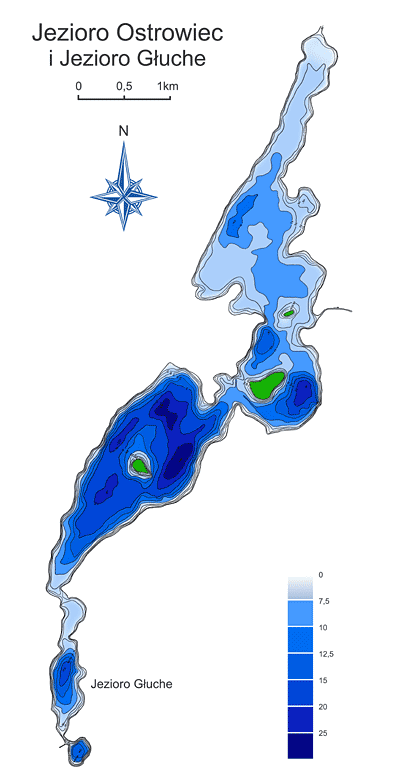Ostrowiec and Głuche Lakes
 The largest lake in the Drawa National Park (369,87 ha); known also as Ostrowiec. It is located in a postglacial gully. It has a very diversified costal line, which in addition to the tall banks gives a variety of vintage points, and makes the landscape of this lake very attractive. Completely surrounded by forests, it is one of the most beautiful lakes of the Pomerania region. It gathers 36,5 million m³ of water. The deepest points of the lake (28,5 m) are east of the Lech Island and between the Okrzeja Island and the efflux of River Płociczna. In the south, with a narrow channel, Lake Ostrowiec connects with Lake Głuche, and further with Lake Małe. Sometimes all three of them are called by the common name of Lake Ostrowiec (total area 387 ha).
The largest lake in the Drawa National Park (369,87 ha); known also as Ostrowiec. It is located in a postglacial gully. It has a very diversified costal line, which in addition to the tall banks gives a variety of vintage points, and makes the landscape of this lake very attractive. Completely surrounded by forests, it is one of the most beautiful lakes of the Pomerania region. It gathers 36,5 million m³ of water. The deepest points of the lake (28,5 m) are east of the Lech Island and between the Okrzeja Island and the efflux of River Płociczna. In the south, with a narrow channel, Lake Ostrowiec connects with Lake Głuche, and further with Lake Małe. Sometimes all three of them are called by the common name of Lake Ostrowiec (total area 387 ha).
In the west, a large peninsula cuts into the lake. Its northern foreland is called Dębowy (Oak) because of the oak trees that grow there. The southern one is called Korea (because of its shape). On the eastern bank the Płociczna efflux is bordered by two forelands: Harcerski in the south and Psi in the north. There are three islands on the lake: Lech (south), Okrzeja (middle), and Pokrzywka (north). They have been nature reservations since before the Second World War. In 1988 it a nature reserve was founded there again and shortly after it was included in the National Park area. The Lech Island is home to a colony of cormorants, and one of the tall pines regularly nests an osprey. Birds may be observed from the yellow hiking trail that goes along the western bank of the lake. The Okrzeja Island is home of the eagle owl. A unique linden forest grows there, as well as a warm-loving oak forest, and some other unique plant species can be found there. The Pokrzywka Island is overgrown with alder-lined meadows with monumental alders, ash-trees, and linden. All three islands provide nests (in tree hollows and human-made bird houses) for grey goose and merganser, which find refuge from land predators there.
The lake’s and its banks’ fauna is very diverse. Botanists have counted 72 types of plant communities here. The water luster is surrounded by straw rush, in the southern parts one can see single twig rush specimen. The fertility of this lake varies from place to place. The flowing northern side is of a eutrophic character, and the bottom is dominated by pond weed, water nimfoil, hornwart, and water thyme. Some unique types of pond-weed were found here. The central part of the lake, south of the Okrzeja Island, becomes closer in character to a mesotrophic lake. In the bottom one can sometimes find part of stonewart meadows.
In the summer, the lake’s temperature is measured by layers, and at the depth of around 10m it drops in lumps to 5ºC. At that depth also the oxygen supply seizes to exist. The translucency of water is 2-3m.
One can often see white-tailed eagles by this lake. In the spring grebes, grey geese, and mergansers are tooting on the water surface. The lake has a very diverse fish fauna. It is dominated by roach, bleak, and perch. In the deeper spots lives the European whitefish, river bream, chub, bream, tench, eel, and pike. Some appearances of the Baltic vimba and of lavaret have also been noted. One peculiarity of the fish fauna here is the lake trout, a very rare in Poland ecological form of trout that spends most of its time in the lake, but moves to a river for the mating season. This lake is accessible for fishing from the fishing docks on the western bank. It has been mentioned in old documents. In the 13th century the border between the Greater Ploand (Wielkopolska) and the Margraviate was to run “per lacum Wusterwitz”. In the 19th century an irrigating canal was built along the western bank, the Sicieński Canal. Around 1985 a bridge supported on 40cm thick pine logs was built over the narrow water path between Lake Ostrowiec and Lake Głuche. It was still in place in the 1970’s.
A yellow trail on the western bank provides public access to this lake. From the trail one can observe the luster of water, the cormorant island, and the swampy alder woods of Żółwia Kłoć.
















